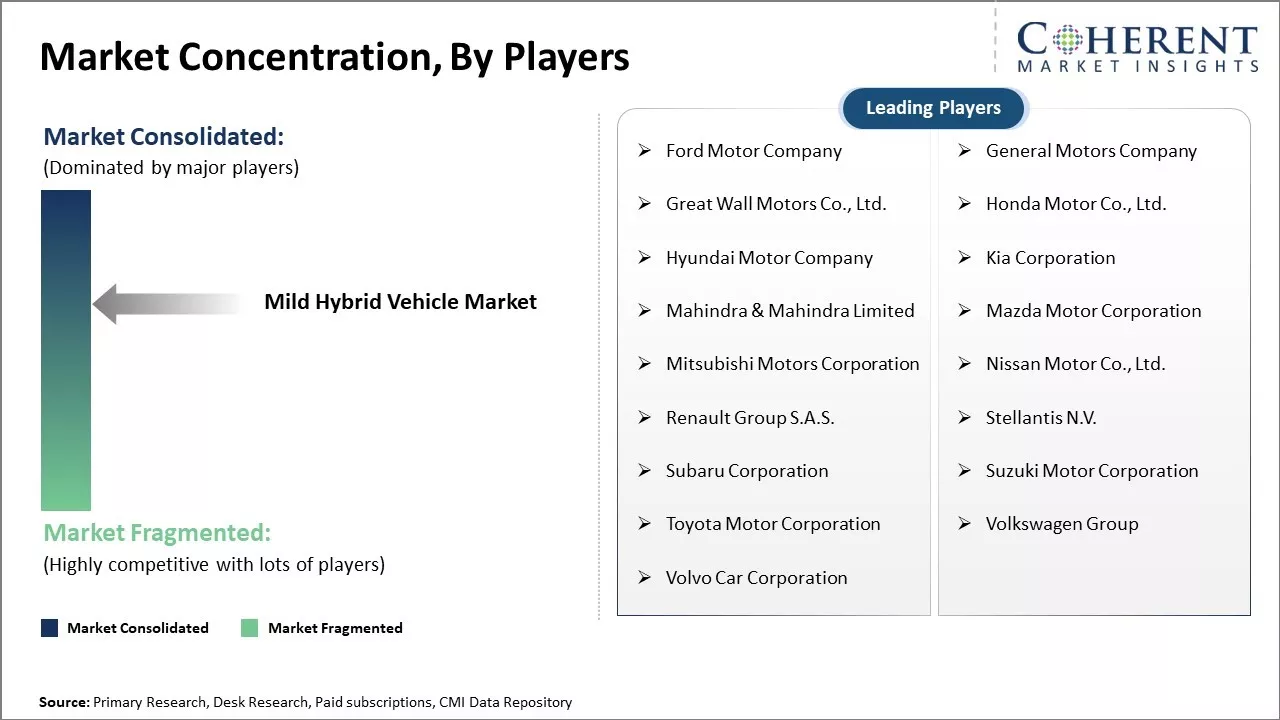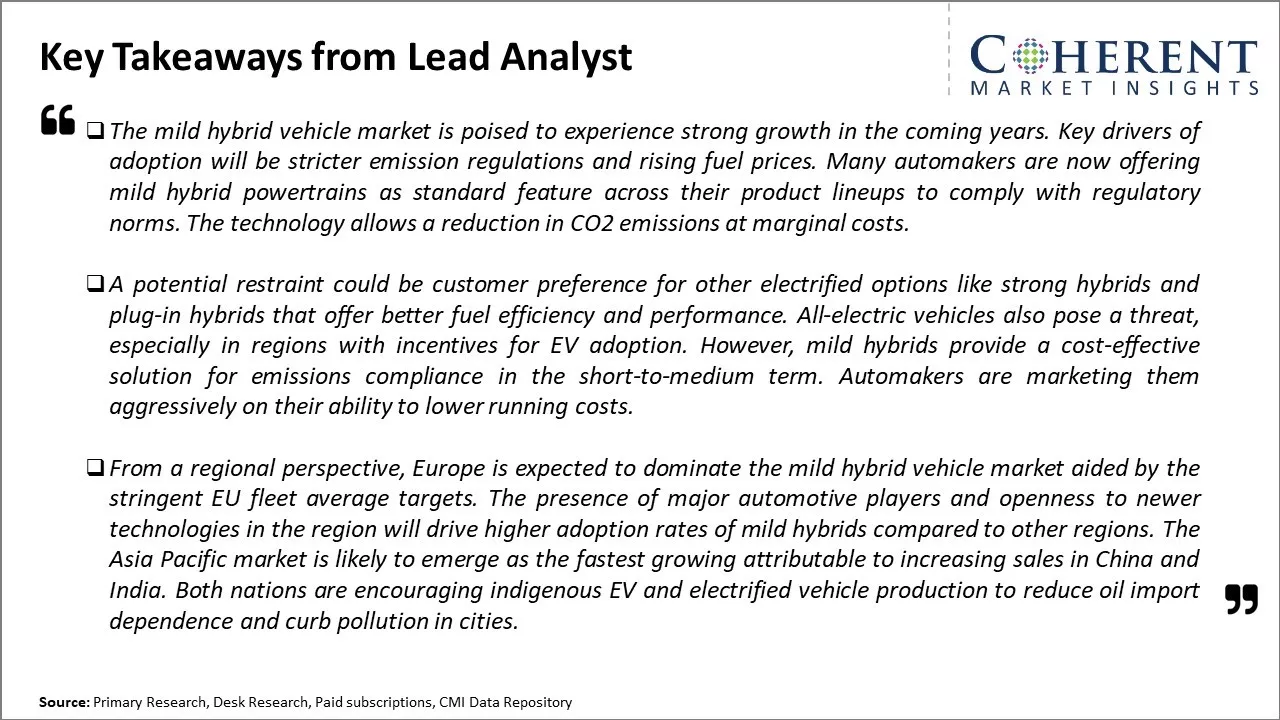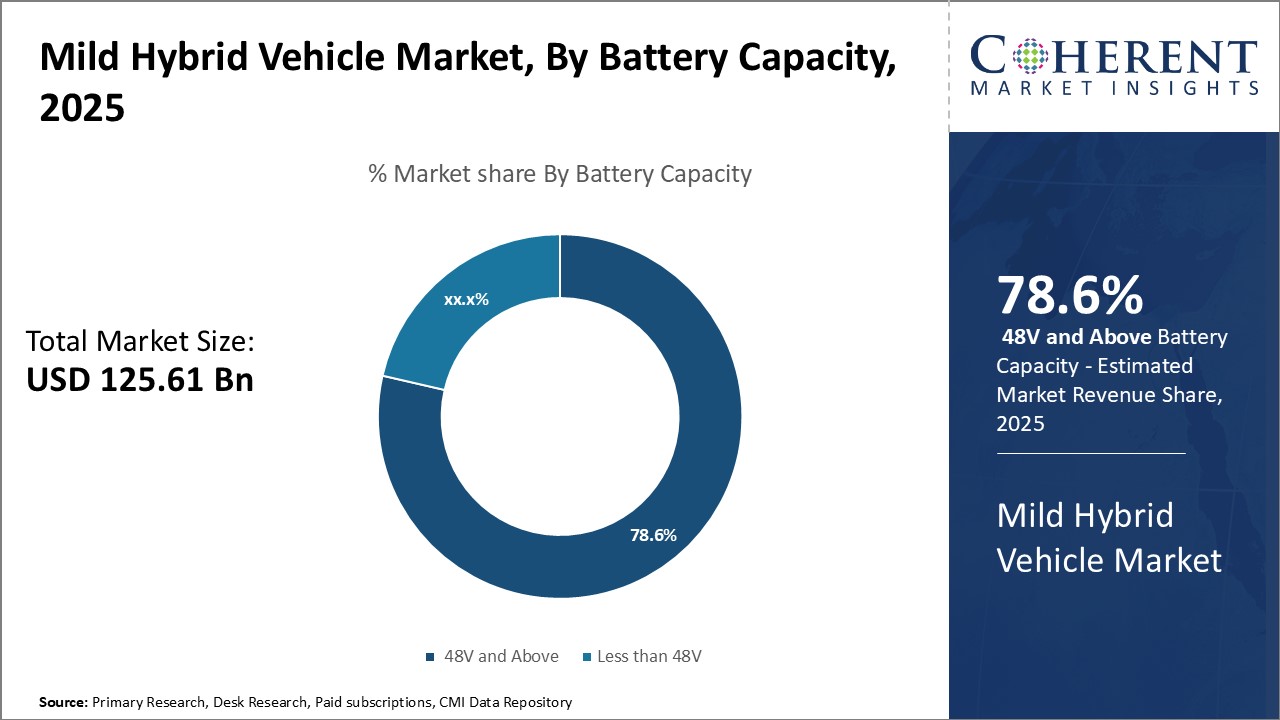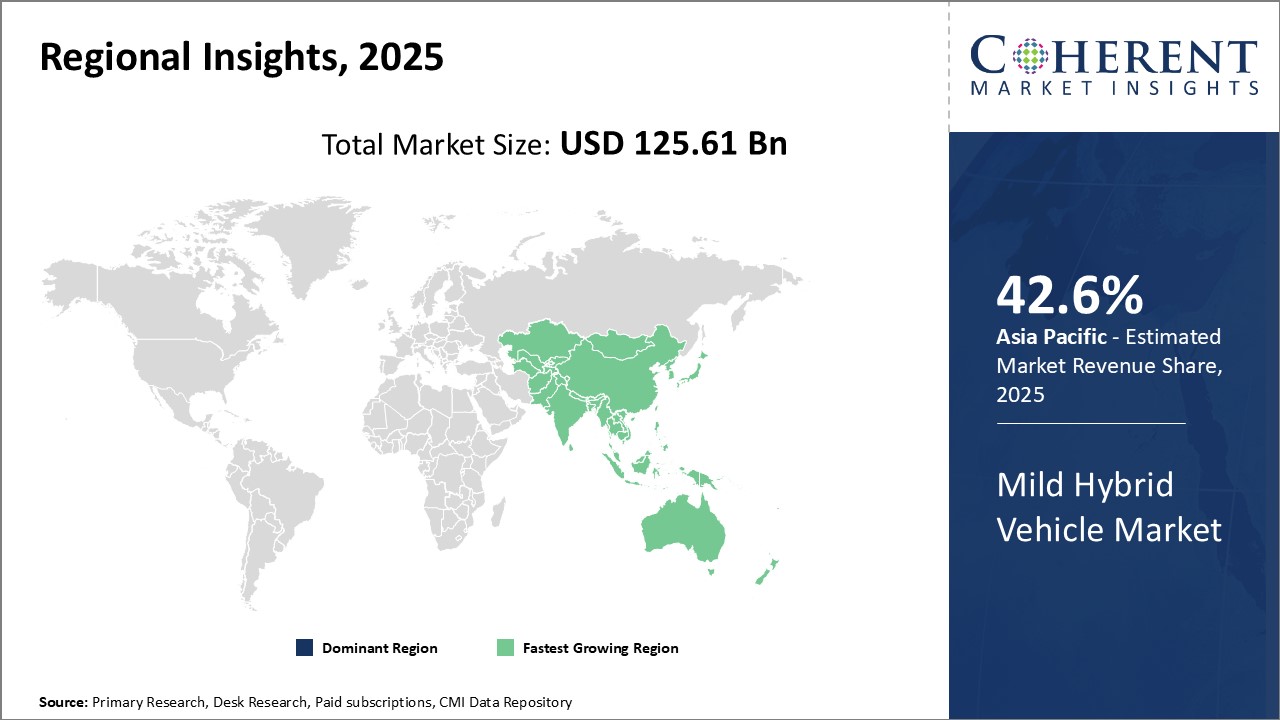Global mild hybrid vehicle market is estimated to be valued at US$ 107.72 billion in 2024 and is expected to reach US$ 311.09 billion by 2031, exhibiting a compound annual growth rate (CAGR) of 16.4% from 2024 to 2031.

To learn more about this report, request a free sample copy
Global mild hybrid vehicle market is expected to witness significant growth over the forecast period. With stringent emission norms and rising environmental concerns, automakers across the world are focusing on electrifying their product portfolio. Mild hybrid vehicles provide a cost-effective option to automakers for meeting emission standards while ensuring operational efficiency. Therefore, many leading manufacturers are introducing more mild-hybrid models. The technology is also gaining acceptance among customers as it offers good fuel economy as compared to conventional internal combustion engine vehicles. Furthermore, technological advancements aimed at enhancing the driving range and performance of mild hybrids can boosts their adoption. However, high purchase price remains a challenge, especially in price-sensitive developing markets.
Reduced Fuel Consumption and Emission Levels
Mild hybrid vehicles help to reduce fuel consumption and emission levels as compared to conventional vehicles which depend solely on internal combustion engines. The integration of battery and electric motor assists the engine especially during acceleration and helps capture energy during braking which is then stored in the battery. This allows the engine to run more efficiently at optimal speeds and loads. Owners benefit from lower fuel costs as these vehicles tend to provide higher fuel economy in city driving conditions. The regenerative braking feature is particularly useful in stop-start traffic situations common in urban transportation. This directly impacts the operating costs for owners in a positive way.
Lower fuel consumption translates to reduced emission of pollutants from the vehicle. As more automakers focus on expanding their electrified vehicle portfolio to comply with tightening emission regulations, mild hybrids serve as a sensible transitional technology. The hybrid system helps optimize the internal combustion engine operations to boost efficiency. Although not as extensive as full hybrids, mild hybrid setups cut down significantly on harmful exhaust from the tailpipe. This benefits the environment as well as the reputation of automakers striving to be seen as sustainable mobility providers. The hybrid technology provides partial electrification benefits without the high battery costs of full hybrids, making it an attractive choice for those looking to minimize their carbon footprint from personal transport. For instance, according to research report published by U.S. Environmental Protection Agency in December, 2023, vehicle fuel efficiency hit an all-time high, while emissions hit a record low in 2022. Additionally, the report confirms that all 14 major manufacturers have met the requirements of the light-duty greenhouse gas program for the reporting period up to MY 2022

To learn more about this report, request a free sample copy
Boost to Acceleration and Driving ExperienceMild hybrid technology enhances the acceleration and overall driving experience offered in conventional vehicles. The integrated electric motor is capable of providing an instant torque boost during take-off and acceleration phases. This allows the engine to work in a more linear operating range for smooth power delivery. The driver feels a stronger and more responsive throttle response resembling that of a vehicle with a more powerful engine. The electric assist compensates for any lag typically experienced with a solely combustion-powered vehicle. This makes overtaking and merging into fast-moving traffic safer and easier.
The improved torque output from the combination of engine and electric motor results in better performance acceleration times. Drivers feel a sense of quickness despite the added weight and complexity of the hybrid system. During regular city commuting, the hybrid technology preserves the drivability and thrill of driving without any drawbacks of lower performance. Automakers are able to package the hybrid drivetrain without compromising on interior or trunk space either. This maintains the practicality expectations of buyers

To learn more about this report, request a free sample copy
Market Challenges: Consumer Adoption BarriersLack of widespread adoption by consumers can hamper the market growth. The upfront costs of these vehicles as compared to standard internal combustion engine models can hamper its adoption.
There is also an ongoing need to improve the fuel efficiency gains achieved by mild hybrid powertrains to further differentiate them from conventional cars and better justify their somewhat higher price tags to value-conscious buyers.
Market Opportunities: Compliance with Tightening Emissions Regulations
Tighter emissions regulations being introduced by governments around the world are increasing the pressure on automakers to enhance the efficiency of new cars. Mild hybridization provides an effective solution for reducing fleets' average CO2 emissions. Rising fuel costs also enhance the value proposition of even modest hybridization. As battery and component costs fall further, the payback period for mild hybrid technologies will shorten, boosting their accessibility.

To learn more about this report, request a free sample copy
Insights, By Battery Capacity - Factors Fuelling Growth in the High-Voltage SegmentIn terms of battery capacity, 48V and above segment is estimated to contribute the highest share of 78.1% in 2024, owing to improvements in high-voltage battery technologies. Vehicles in this segment are able to offer more powerful electrical boosting and coasting capabilities compared to lower-voltage mild hybrids. The additional electric torque assist provided by high-voltage batteries allows for quicker acceleration and helps automakers comply with increasingly stringent fuel efficiency and emissions regulations.
Advanced lithium-ion battery chemistries have enabled the development of higher energy density 48V+ battery packs that take up less space under the hood while offering greater electric driving range. This makes them an attractive option for automakers seeking to hybridize larger vehicle classes like SUVs and trucks. Battery manufacturers are also working on new lithium-ion battery cell designs optimized for high-power applications in automotive mild hybrid systems. Improved battery lifespans and reduced costs will drive further uptake of 48V+ mild hybrid technology across a wider range of vehicle in the near future.
Governments around the world continue to introduce new policies and incentives promoting electrified vehicles as a means to curb transport sector emissions. The 48V+ mild hybrid category provides a lower-cost hybridization solution for automakers compared to full hybrids or plug-in hybrids, while still allowing them to offer hybrid versions of their most popular nameplates. As regulatory compliance pressures increase and consumers become more environmentally conscious, the business case for adopting 48V+ mild hybrid powertrains will strengthen. If battery costs decline as expected, many forecast the high-voltage segment becoming the predominant mild hybrid configuration industry-wide by the mid-2020s.
Insights, By Vehicle Type - Factors Contributing to Passenger Vehicle Dominance
Passenger vehicle segment is estimated to account for the major share of 69.44% in 2024, due to bulk sales in the mild hybrid market due largely to higher unit volumes and fleet turnover rates compared to commercial vehicles. Passenger car buyers are increasingly influenced by reported fuel economy figures and seek hybrid versions of in-demand nameplates to reduce ownership costs. With many new emission rules applying specifically to passenger vehicle fleets, automakers prioritize introducing mild hybrid technology into their mainstream passenger car lines to lower reported average emissions.
Electric boosting and extended idle stop-start functionality provide the largest real-world fuel savings in city driving cycles that mirror most passenger vehicle usage profiles. Mild hybrid systems are ideally suited for passenger cars, which typically complete more short trips with frequent stops. This maximizes the fuel-saving potential of mild hybrid technologies in applications where larger batteries or longer all-electric ranges found in full hybrids may not be fully utilized.

To learn more about this report, request a free sample copy
Asia Pacific region is not only expected to hold the dominant market share of 42.1% in 2024, but it is also projected to witness the fastest growth rate globally, with a staggering CAGR (Compound Annual Growth Rate) of 21.78% in 2024.
Several countries in Asia Pacific are experiencing rapid economic growth, leading to a rising middle class with more disposable income. This translates to increased demand for personal vehicles, and mild hybrids offer an attractive option due to their fuel efficiency and affordability compared to full hybrids or electric vehicles.
Governments in the region are actively promoting fuel efficiency and environmental sustainability. These are implementing stricter emission regulations and offering incentives for purchasing eco-friendly vehicles, such as tax breaks or subsidies. Mild hybrids perfectly align with these goals, providing a significant improvement in fuel economy without the high cost of plug-in hybrids or electric vehicles.
Asia Pacific is home to a strong automotive manufacturing base, with several leading car manufacturers headquartered or having major production facilities in the region. These manufacturers are investing heavily in developing and launching new mild hybrid models to cater to the growing demand. With a combination of these driving forces, Asia Pacific is poised to be the market leader in the mild hybrid vehicle market in the near future. This technology offers a practical and cost-effective solution for consumers seeking better fuel efficiency and reduced emissions.
Mild Hybrid Vehicle Market Report Coverage
| Report Coverage | Details | ||
|---|---|---|---|
| Base Year: | 2023 | Market Size in 2024: | US$ 107.72 Bn |
| Historical Data for: | 2019 to 2023 | Forecast Period: | 2024 To 2031 |
| Forecast Period 2024 to 2031 CAGR: | 16.4% | 2031 Value Projection: | US$ 311.09 Bn |
| Geographies covered: |
|
||
| Segments covered: |
|
||
| Companies covered: |
Ford Motor Company, General Motors Company, Great Wall Motors Co., Ltd., Honda Motor Co., Ltd., Hyundai Motor Company, Kia Corporation, Mahindra & Mahindra Limited, Mazda Motor Corporation, Mitsubishi Motors Corporation, Nissan Motor Co., Ltd., Renault Group S.A.S., Stellantis N.V., Subaru Corporation, Suzuki Motor Corporation, Toyota Motor Corporation, Volkswagen Group, Volvo Car Corporation |
||
| Growth Drivers: |
|
||
| Restraints & Challenges: |
|
||
*Definition: Mild hybrid vehicle market refers to the automotive industry segment focused on producing and selling vehicles that are partially electrified with mild-hybrid technology. These vehicles have small battery packs and electric motors that provide auxiliary power assistance to improve fuel efficiency but do not enable full electric-only driving ranges like regular hybrids or plug-in hybrids. Mild hybrid systems are integrated into traditional internal combustion engine vehicles to reduce emissions and boost fuel economy by a few miles per gallon through features like start/stop functionality, regenerative energy system.
Frequently Asked Questions
Joining thousands of companies around the world committed to making the Excellent Business Solutions.
View All Our Clients